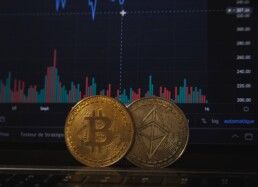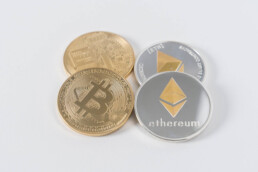Trading vs Investing, with Bitcoin
In this article we talk about bitcoin trading, specifically seeing the difference between investing and trading.
First of all we need to define what bitcoin trading is.
Bitcoin trading is the exchange of fiat currency or other cryptocurrencies for bitcoin, on an exchange, with a short-term vision and then returning to fiat currency by exploiting the high volatility to gain in fiat currency.
We must understand that the difference between investing and trading refers specifically to the long or short term view. In fact, investing means buying bitcoin today and then reselling it in 3 4 or more years, regardless of its movements. Trading bitcoin, on the other hand, means taking advantage of its movements to make money.
The two views are both correct and are the result of two different points of view. Investors generally believe in the underlying technology and ideology of Bitcoin, seeing in it a possible bright future for the asset. Traders, on the other hand, may not be interested in technology but are interested in the short-term economic potential of the instrument, so ups and downs are welcome when positioning in a trend.
The two visions can be experienced simultaneously. Nobody forbids you to put some bitcoins away on a wallet for the long term and at the same time trade others for the short time.
A popular slang term in the bitcoin world is hodl, which refers to someone who has long-term invested in bitcoin. The term comes from a mistake that has become popular on the bitcoin talk forum.
At every big down fall, don't panic and hodl!
Traders not interested in bitcoin technology consider it an interesting asset for their work as the market is open 24 hours a day all year round. The volatility of the currency and its riskiness are the perfect fuel for day traders and swing traders.
One last observation. Don't turn a short-term trade into a long-term investment just because the market has gone in the opposite direction to what you thought and your loss percentage became important because you didn't use the stop loss.
Exchanges and Order
Exchanges are the places where sellers and buyers meet together. This online sites are dedicated to the trading of various cryptocurrencies.
There are various types of exchanges, from the largest and most established with users from all over the world to the smallest ones that have a predominantly regional audience, as it happens in Japan and Korea.
The main features that interest us in an exchange are which coins are traded, the volumes and costs of the exchange and the safety of the sites.
Security as you well know is the fundamental factor of this world, and it weighs on your shoulders.
Exchanges work just like the stock exchange and manage your money. There is an order and sales book, you will have your own personal wallet but owned by the exchange. With some of these wallets you can even make loans to other users and get paid.
Now, there is no 100 percent secure exchange and these entities are in the hands of companies that obviously have profit as their reason for existence. Exchanges can be attacked by hackers or they can scam users, blocking funds and running away with money. For this reason you will have to leave as few coin or currency as possible on the exchange.
The largest exchanges are structured to resist to attacks and attempted robberies, but the provision is never too much. Each exchange takes care to put you in a position to protect your account, so don't be lazy and take the necessary actions to protect yourself
Moving on to coins, here we have another difference. In almost all exchanges bitcoin is traded but some small coins, with very low volumes and illiquid, are traded only on one or two exchanges in the world. This forces us, if we want to betray them, to rely on these actors who are unknown to most. In this case we will have to read the rules of these exchanges because they may not allow the exit of funds below or above a certain value, or forcing us to go through the kyc procedures and this may take a long time to be resolved.
The volumes of an exchange are an important signal, meaning that that data coin on that given market is very or little sold and in demand. Many volumes equate to many buyers and sellers, therefore a market rich in money that is defined as liquid. Small exchanges with low volumes are therefore illiquid.
Each exchange has usage costs, check them before deciding on which exchange to operate more often.
Also remember that although bitcoins are all the same, on different exchanges they are sold at different prices, giving rise to arbitrage phenomena.
When you go to trade on exchanges, you will have different types of orders to buy or sell. Let's see some of them.
Let's start with the simpler than the market order or market order. In this specific order, the purchase takes place at the sale price of the lowest asset and the order is not stopped until the requested quantity is reached.
Let's take an example. I purchase 20 ethereum with a market order. At that moment on the book, the first lots on sale at the lowest price will be 10 ethereum at $ 200 and another 20 at $ 210.
With this order I will buy 10 ethereums for $ 200 and another 10 ethereums for $ 210. With this order, the price does not matter, but the quantity indicated.
In the case of a sales order of this type, the behavior is the same.
Another kind of order is the limited order. In this case, when we go to create the purchase order, we enter the quantity and the decided price. In this case we can put a price slightly below that of the moment or much lower, it all depends on how we see the situation on the market. This type of order could be either unfulfilled or partially filled.
Again using the example above, if we placed an order for 20 ethereum at $ 200, with a current price of $ 210, we would have to wait for a descent to ensure that the order is executed. It could happen that only 5 ethereums on the market sell for $ 200, so our order would be partial.
Also in this case when the behavior of the order in the event of a sale is the same. Price and quantity will be fixed and may not be reached.
A more complicated type of order is the stop loss order. This kind of order incorporates a sales strategy that wants to cut losses, a stop loss in fact. When the trend is uncertain you can use this order to protect yourself.
In case we still have an order like this for 10 ethereum at $ 200, with a stop loss at $ 190. If our long view is right, from our purchase at $ 200 ethereum it will go up in price and at the right time we will take profit. However, if we made a mistake and ethereum starts a negative trend, our order will automatically sell the position at 190 dollars, saving our account.
Viewed from the point of sale, this type of order can be changed with a higher price which turns into a take profit. If ethereum begins a slight positive trend we will be able to move the stop loss in equal to $ 200 or if the rise is more pronounced the figure could be even $ 210 and beyond. In this case we would continue to have a position within an uptrend that would be sold for a gain in the event of a reversal of the trend.
Bitcoin Lightning Network
Lightning Network is one of the solutions for one of the problems of bitcoin.
Lightning Network is a system created on top of the Bitcoin blockchain, with specific rules, to have fast and fee-free transactions.
We all know Bitcoin is cool but it's not perfect. Bitcoin has limitations such as the speed and cost of transactions.
In a particularly dense period of transactions, not high enough fees and blocks every 10 minutes, can make your purchase or move from one wallet to another really slow and expensive.
Lightining network should solve all these problems. The concept of this system has been developed since 2015 and we have to imagine that it works as if it were a layer cake.
On layer 1 we have Bitcoin with the blockchain while on layer 2 we have the lightning network system.
This feature is created specifically for micropayments, so that all micro transactions are not written on the bitcoin blockchain. At least not immediately.
The payment channels are created so if I want to send funds to a friend of mine or to a shopkeeper we can open a payment channel between the two of us, with our payments not involving the main blockchain. the transaction will take place at the speed with which the two wallets are able to communicate with each other.
When the transactions between the two wallets are complete, a main transaction will be created and written to the main Blockchain.
Now, if we thought of a series of regular, small-scale transactions, such as coffee at the bar every morning, each transaction sent to the main bitcoin blockchain would cost us more in lost time and fees than the transaction itself. Does it make sense to spend 10 dollars of coffee and 20 on commissions?
NO
Now let's imagine opening a payment channel for my entire CY Mood team with my favorite bartender. Upon opening the payment channel, both parties deposit a certain amount of money to guarantee the total transactions. If I know my team drinks 100 coffees a week I will deposit an equal or greater amount.
On the main Bitcoin BlockChain there will be only 2 transactions, namely the first transaction to open the payment channel and deposit the coin and a second to "close" or complete the payment
Now if we go back to our second layer, thousands millions of transactions can take place within the payment channel without these being written to the main blockchain. My team will be able to drink thousands of coffees and every time they buy, they will write an X BTC transaction to the barista
Weekly, monthly or every time my barista friend wants to cash out the coffee bitcoins, he will decide to write the transaction on the main BlockChain.
The system works best for small repeating transactions, we can think of our baker or the barber. There is obviously a system against scams, for those who want to close the payment channel in advance and not pay anything. In this case, the total of the initial deposit would be sent to the scammer. This greatly discourages scams.
Another interesting ability of the Lightning network is the ability to make payments to people with whom we do not have an open channel, but using other people's channels.
Being exposed in crypto consciously and knowing the dangers.
Why investing in cryptocurrencies? Why starting to study a whole new environment with a huge initial difficulty? Why endanger that part of our assets that we have decided to allocate in cryptocurrencies?
Because yes.
We start from the idea that the world of investments as a whole is huge, and that Blockchain is currently the most recent technology and with the greatest growth push on the planet. Investing in blockchain projects is within everyone's reach, so even less capable investors with little experience or just beginners can invest. Investors of this type are the ones who will make the biggest mistakes so they need to understand the various projects and decide if they are worth our money.
If you remember the dotcom bubble, you could have invested in amazon or google or other realities of the early internet era ... But we only remember those who survived and we forgot all those realities that had stratospheric growths in a few weeks, and then see your stock value crash to the downside and disappear from the market. But only from the market, not from the sad and shocked minds of their investors ...
Let's forget for a moment Bitcoin and Ethereum which are now the two champions of the crypto world, the universe of Blockchain projects is huge and varied.
It should be immediately understood that there are many projects that are or have turned out to be exclusively scams or clones of other more noble and serious projects, which with scammy name and various tricks have simply tried to drain funds from inattentive and inexperienced investors.
Currently over 90 percent of blockchain projects launched and funded have failed, most without writing a single line of code. Aware of this, and also aware of the fact that the Blockchain is the future and it is time to be inside it, as investors we must ask ourselves some simple and basic questions to understand where to put our funds.
Let's start with the first doubt to be eliminated, if the project we are evaluating creates a product or service that solves a real problem and if this is in line with Blockchain technology. Not all projects showed off as crypto friendly are suitable for the Blockchain. In case it is really suitable, and perhaps thanks to the blockchain it solves an unsolvable problem, well we have taken a big step forward. Those who do not respect this rule can be eliminated in a long-term investment perspective.
After that we will have to understand if the evaluated product really exists or is still under development or worse, it is only on paper and not even explained in a perfectly understandable way. In fact, a product under development takes months if not years to be launched on the market, extending the time for the return of the investment and therefore enormously increasing the risks for the investor.
After the product, the team should be checked. It is clear that the team must reflect experience in the sector to which the project belongs and the individual members must be experienced and competent, with a good curriculum. The team will then have to try to create partnerships with various companies already on the market. Experience, partnership and reputation are excellent indicators.
Another aspect to check is the type of token created to finance the project and offered to the public. There are utility tokens that offer a service linked to the project and whose value changes according to company and market trends. Otherwise, security tokens can be offered, which are backed by real company assets. These tokens are regulated and, in addition to offering an extra guarantee on the project, they carry rights on assets owned by the company.
Another point to check for the investor is the control of who issues the token, whether through an exchange or directly by the company in charge of the project. In the case of little-known exchanges with an unclear past, here is an alarm bell.
And this point makes us shift our attention to the dangers of investing in cryptocurrencies. Danger seen as the possibility of losing all our accumulated value.
First of all we need to define and differentiate the types of risks we run by investing in crypto.
We have two main type of risk, which are technical risk and financial risk.
When we talk about technical risk, we mean any problems we may have with wallets, exchanges and other technological issues.
The wallet is your property and it is your responsibility to manage it in the best possible way. One of the things that you cannot predict, however, is a possible bug that cause to hack the wallet and make you lose your funds. For this reason, the best choice to always make is to look for and use only the most successful wallets created by companies that invest a lot in security for their products. This choice is yours and it is your responsibility.
The same goes for the choice of the exchange on which to operate. An exchange can be attacked and its wallets can be hit and looted. But a large exchange has the funds and a strong need to protect itself, so it will always be state of the art in protecting its business and consequently its users. On the other hand, small exchanges do not always have these capabilities and are much more risky. The risk you take, however, can be rewarded since small exchanges often have coins that are not present on the larger ones and the movements can be more violent and faster, making you gain or lose more.
Leaving your coins on an exchange is a big risk. Remember that the coin that is on your wallet on the exchange is in the wallet of an exchange and not on your proprietary wallet. If something should happen to the exchange, you are almost certain that you have lost your parked coins waiting to be traded. In my experience it is better to spend something on movements from and outside your wallet. You run the same risk when you borrow your coins on an exchange that gives you this option. In this case, however, the risk is greater since your coins will be blocked for the entire time of the loan, not allowing you to quickly exit the exchange for whatever reason you want. It should also be considered that exchanges do not always allow immediate exits since the general timing is between 12 and 24 hours.
Scams are a full-blown reality of this world, we have made an article with the list of the most famous so we can teach you how to defend yourself. Learn more about Scam here.
Another problem you may find is the technological protection of the coins. Coins like Bitcoin and ethereum are difficult to attack, the development teams are very large and made up of capable programmers with very large budgets. On the contrary, coins just put on the market and therefore small and with few developers could have bugs that undermine their intrinsic safety. Choosing the coin to invest in is your responsibility, you take a risk in any case but it is a risk that you can manage.
Therefore the risk is reduced by using high quality wallets, exchanges of proven trust and coins among the most liquid. If you use the right things in the right way you have lowered the problematic risk.
Now let's face the financial risk.
The major problem encountered in the crypto market is the extreme volatility of prices, given by a combination of low market liquidity, thin books and a strong presence of whales that can move the market. However, this volatility is the key to making money. If we position ourselves in the right trend, our coin will obviously have a growth that is impossible on conventional markets.
But be careful, there are no guarantees regarding the growth of the price of a coin. It is not acceptable to buy something at random and abandon it, and then hope that in the following months or years it will increase in price.
The same goes for the underlying of each coin. The underlying of each coin is the development and use technology that it has in the real economy. If this technology is useless, wrong or totally non-existent, it is obvious that the value could collapse and reach zero.
There are Ponzi schemes like OneCoin which have no underlying and which are based only on the trust placed in them. When confidence collapses, OneCoin is like a fake baseball card. I only mentioned OneCoin for the trust issue, OneCoin is not a cryptocurrency.
Bitcoin has value because people believe in this technology and believe in the monetary design philosophy that underlies it. Bitcoin is also valuable because it is used according to its philosophy. The use of a coin, like the trust that the public has in it, creates value on the market.
There are some basic things that you must always remember.
By investing in anything, you are taking a risk. Risk that you can lower but never eliminate. Balance the risk on your profile, never overshoot it. Every mistake is always paid with your money.
In the long run there are no certainties about the value, while someone more famous and better than me said that in the long run we are all dead.
The risk of losing and zeroing your trading account is as real in crypto currencies as on any financial instrument. On crypto and derivatives, obviously all this can happen very quickly.
Anyone who promises you fast, safe and risk-free earnings is lying and wants to scam you. Say goodbye to this fool.
Virgin BTC- A brand new Bitcoin...
Speaking of mining, you also need to know what virgin bitcoins are.
A virgin bitcoin is a bitcoin that has just been mined or that has never transacted on the blockchain or that has a certified transaction history.
In the world of cryptocurrencies, many scams have occurred against bitcoin users, while other bitcoins have been used for illegal activities, theft or money laundering.
Since the blockchain is visible to all, it is possible to track the history of every single bitcoin by checking its transaction history. Which is difficult but real.
The authorities of a country could keep an eye on some wallets with bitcoin inside involved in criminal actions. In this case, if these were passed on the wallet of some exchange, they could be blocked or not accepted by the exchange.
This can create concerns and some financial intermediaries may not accept bitcoins of non-certified origin.
And here a Bitcoin without transactions is very useful and therefore its price will be higher than a normal bitcoin, in the order of 20 or 30 percent more.
The increased regulatory push drives the demand for virgin bitcoins.
Bitcoins without a clean history are not to be considered dirty or unused but we simply don't know what their life was like before we had them in our wallet. Life that may have been extremely adventurous
ICO
What is an ICO?
Ico stands for Initial Coin Offering. That is an initial offer of coins or tokens.
It has been the preferred method of funding in the world of crypto start-ups. In fact, in 2017 the never-ending race to grab the latest launch on the market made this startup financing method famous. Serious and much less serious companies have launched on the market by offering tokens and projects, for the most part totally useless and unusable, causing a bubble to develop on the market which then exploded. The frenzy of users has increased the values but the market has brought them back to much milder prices.
But how is an ICO structured if we wanted to do it today?
An ICO is generally done on the Ethereum BC via the creation of a token which is offered to the public. All this goes through a smart contract that is activated when Ethereum is sent to it. Learn more about Smart Contract here.
Each time the user sends eth to the smart contract address, it sends the number of tokens calculated based on the number of eth received from a given address. The ICO ends at the end of the tokens set by the smart contract or at the time limit of the offer.
Each user who participated will find the assigned number of tokens in his sending wallett and can thus move them at will, always based on the rules applied by the smart contract. Learn more about Smart Contract here.
As you can see, Ethereum is sent by token. Currently, ICOs have gone out of fashion and the frenzy has disappeared with them. Most of the projects failed and the values stood at large percentages below all-time highs. ICOs have been like the DOTCOM cryptocurrency bubble, a painful but useful step to cleanse the market of useless projects.
Step 2 - What is a Blockchain?
Blockchain, a term now abused and inserted inappropriately in many contexts because it is cool and makes us feel important.
Sounds like in the early 2000s we heard from our shoemaker who had opened his website and he has no idea about what doing with a website.
But what is a blockchain ? What is his purpose? And why is it useful in some situations?
The BlockChain is a distributed and decentralized digital database, shared on a series of nodes, verifiable by anyone and immutable over time.
It is a digital register, whose entries are grouped into blocks linked together in chronological and sequential order, whose integrity is guaranteed by the use of cryptography
Decentralization is guaranteed by the network of nodes distributed around the world, and each of these has a copy of the database, which is distributed among all nodes in the network. To put it simply, nodes are computers around the world owned by individual enthusiasts or large mining companies.
Each new block addition to the distributed blockchain is globally governed by a shared protocol.
Once the addition of the new block has been authorized, each node updates its private copy with the guarantee of automatically discarding fraudulent or incorrect blocks.
Therefore the information written inside the distributed blockchain, owned by each node will always be visible to everyone and this information will never be changed in the future.
It is practically impossible to change information within a block, the computing power required would be enormous.
Thanks to these characteristics, the blockchain is intrinsically superior to normal databases and central controlled registers, managed even by recognized and regulated authorities.
As with every product, variants are developed and various types have also been developed for the Blockchain, created to meet the various needs of every actor operating in the world.
in detail:
- Public blockchains: Blockchains are open to everyone and accessible to anyone. Each node holds a copy of the database and can participate in the decision-making process regarding the state of the ledger. They are defined as "permissionless". Example: the Bitcoin blockchain
- Private Blockchains: They are closed Blockchains where only one or more pre-selected nodes can perform the function of validating the network. They are defined as "permissioned". Example: the Blockchain of a private foundation or a company
- Mixed Blockchains: They are partly public and partly private Blockchains
- Sidechains: They are blockchains derived from the mother blockchain but connected to it. They are in effect autonomous blockchains on which it is expected that there are coins / tokens different from those circulating on the parent chain but which, if necessary, can "move" from the sidechain to the parent chain and vice versa.
To recognize a blockchain we need to find these elements:
- Transaction (transfer of value from one address to another)
- Block (element that contains transactions)
- Node (element of the network that performs for example mining or validating transactions)
- Peer to peer network (network in which all nodes can communicate with each other)
- Smart contracts that deal with the management, fulfillment, execution and payment of the agreements between the parties
In these days, the blockchain is used practically only for payments and exchange of goods and services.
But we can already speculate that in the future, its usefulness may be much wider.
To date, it is assumed that the blockchain can be used for situations where traceability and information security are required, such as:
- Sharing of health information between different platforms and institutions;
- Schools, academia, training areas, issuing of certificates
- Management of sporting events, demonstrations, Olympics
- Management of betting in general and casinos
- Real estate sales and land registers
- Traceability of non-profit and charitable donations
- Monitoring of guns, ammunition and explosives trade
- Law enforcement and public safety management
- Cybersecurity
- Systems for digital and biometric identification
- Production and sale of diamonds or raw materials
- Insurance and leasing sector
- Wills and inheritance
- Tourism
- Traceability of supply chains
- Certification of works of art
- Transparent online voting, safe from manipulation and fraud
- Banking, finance and investment platforms
- Payment and money transfer systems
- Loyalty cards and gift cards
- Telephony
- Trade and industry
- Automotive sector
Summarizing the Blockchain:
- It is decentralized (it does not have central authorities, everyone can see, use and consult it but no one owns it)
- The protocol is open (in public blockchains)
- Certifies that "something" (a transaction of value, a change of ownership) has taken place. The transaction cannot be censored by a central authority
- A transaction cannot be prohibited, censored or regulated by a sovereign entity (e.g. credit or debit card blocking)
- It is verifiable by anyone (in the traditional financial system, the system controls everyone while in the blockchain ecosystem, everyone controls the system)
- Cannot be tampered or falsifiable (intrinsically safe consensus protocol)
- Solves the problem of double spending
- It is immutable over time. Once a transaction has been validated, it is fixed for "life"
- It is dynamic in the sense that blocks are always added
Step 3 - Wallets
In this article we're going to talk about cryptocurrencies wallets. We will face all types of wallet to discover this super important tool of the crypto world.
The wallet is the tool to use to interact with a blockchain.
Wallets can be divided into software, hardware and paper wallets. These can be considered Hot or cold wallets.
Let's start by saying that most wallets are of the software type because they are more practical to use than the others. However, hardware wallets are the safest option, while paper wallets are now an outdated option. But let's see how it works.
Any wallet allows you to interact with the Blockchain, creating the information necessary to create transactions, receive and send the crypto currencies compatible with the wallet. The wallet does not "physically" contain the coins, but rather the public and private keys to operate on the blockchain and the public address that is created based on public and private keys.
The address is a specific point on the blockchain from which to receive and send coins. Coins never leave the Blockchain but simply change their address.
For this reason, you now understand why the private keys of the wallet should never be revealed. In fact, the private key is the only way to access your coins. In case of a possible loss of your mobile phone, you will be able to access your wallet again with the private key.
Now let's face the difference between cold and hot Wallet. In fact, wallets can operate in a different way.
A hot wallet is any wallet connected to the Internet. When you create any exchange account and transfer coins from your wallet to the address assigned on that exchange, you are transferring funds to the exchange's hot wallet, so that your funds are immediately available for trading.
Cold wallets have no Internet connection, so they are safer from cyber attacks and better set up to store coins over the long term.
Now let's see the different types of wallets and which is the best compromise of use.
Let's start with the Software wallets, there are of all types and characteristics, and specific by currency. Obviously, the vast majority are connected to the internet, so they are hot wallets. Software wallets are divided into web, desktop and mobile wallets.
Web Wallet
With a web wallet, you can access the blockchain with a browser interface without having to download or install anything. The most classic example is the wallet of any exchange.
You create a new wallet and set a password to access it. In the case of an exchange wallet there is no private key, you are entrusting your funds to another person, in this case the exchange
Desktop Wallet
The desktop wallet is software that you download and use on your computer.
A desktop wallets give you full control over your keys and funds.
When the desktop wallet is created, in most cases a file called "wallet.dat" is created and stored locally on your computer. This file contains the private key information used to access your addresses, so it must be protected. Remember that if you delete it or lose your computer and don't have a backup, you lose all the funds on the wallet.
A good solution is to export the private key or seed phrase corresponding to your newly created wallet, so that it can also be used on other devices at a later time. Since the wallet is on your PC, it must be protected from malware or viruses.
Mobile Wallets
Mobile wallets are a very similar alternative to desktop wallets but designed for smartphones. They are the most practical wallets for everyday use as they allow you to send and receive crypto by scanning QR codes. The problem of viruses and malware is also present here, so you need to protect your device. In addition, given the daily use of the smartphone, it is necessary to have all the back up of the wallet for any recovery following theft or loss.
Hardware Wallets
Hardware wallets are physical electronic devices, not connected to the network except for their use. They generate random numbers to create public and private keys that are stored within them. Their intrinsic greater safety, however, is balanced by a less simple and quick use.
Hardware wallets are used in case you want to keep large amounts of crypto for a long time. The access PIN must always be set and the recovery phrase saved as in web wallets.
Paper Wallet
the paper wallet is a piece of paper on which a public address and its private key are physically printed via QR codes. Code scanning allows you to perform cryptocurrency transactions. This kind of wallet can be considered a good alternative to long-term crypto storage, given its resistance to online attacks.
The biggest problem lies in the fact in order to use the paper wallet, the total amount of crypto currencies in it must be moved.
If we have a 15 Bitcoin wallet and we only have to move 3 of them, we will first have to make an intermediate step to another address where you will send all 15 bitcoins, and then from there send the 3 you need. The remaining 12 will then have to be put back safely on another paper wallet
Remember that your paper wallet will be empty after its first outgoing transaction. So don't hope you can use it again later.
As we have already repeated, it is essential for each wallet to have the back up and the seed phrase to recover their wallet in case of problems.
Learn more about safety about your Coin here.
Step 1 - Cryptocurrency and Blockchain
In the first educational post of the CY Mood Team, we believe it is correct to start with the most useful base for the average user and define the tools that we are going to use in this strange world.
In this post we are going to define what is a cryptocurrency and we will introduce some of the "technical" terms that you will come across as you enter this environment and which you will find in future articles.
This terminology will then be the subject of further articles.
Cryptocurrency
First concept to learn: in general a cryptocurrency is a digital asset that uses cryptography to protect financial transactions, to control the creation of additional units and verify the transfer of assets from one address to another.
A cryptocurrency is designed to function as a medium of exchange, one of the fundamental functions of money.
True cryptocurrencies are decentralized and are not controlled by a central entity. This feature will be studied more deeply for future articles.
Blockchain
This decentralization works through a tool called blockchain, a distributed ledger in a network of connected computers.
The BlockChain, it is a live record of all bitcoin transactions. The blocks are made of the transactions within them, and the blocks are linked together in an indissoluble way.
The block is created when a set number of transactions are made and the block can contain a maximum number of transactions. Arriving at this number, the block is closed and added to the block previously mined and linked to it.
When a Bitcoin transaction happen, the data is communicated to the network of computers that validate the transaction, this add the transaction to the bitcoin ledger and transfer the ledger change to all computers on the network. Since there is a maximum of data that can be saved in a block, a block is closed approximately every 10 minutes.
Bitcoin
The first cryptocurrency created in the world was Bitcoin, currently the most famous and expensive. It was created in 2009
Over the years, other types of cryptocurrency other than Bitcoin have been created, which can easily be described as Altcoin or Alternative Coin or more generically Token.
Token
A cryptographic token is a currency on Blockchain that not only concerns any financial payments, but also the application of decentralized apps or tools and the so-called smart contracts
Mining
Cryptocurrencies are created through a process called mining, which is the validation of transactions in the networks of this cryptocurrency. There are different types of mining, but this will be addressed later in another article. Learn more here.
Wallet
The wallet is where you can keep all your coins. Different types of coins have different types of wallets. Learn more here
Legality
Cryptocurrency is legal in most of the world. There are only a few contexts where they are completely banned while in other countries like Japan, cryptocurrencies are just an investment tool like others.
Why does Bitcoin have a shadow of illegality?
Most people think that Bitcoin is illegal, but this idea was created by the media with the story of the market for illegal goods and services called the Silk Road, where the payment tool of choice was Bitcoin. Learn more here
Satoshi Nakamoto
Satoshi Nakamoto is the inventor of Bitcoin and the Blockchain. At least that's what we know, what the legend says. Who is he? Nobody knows. Is he a person? Mystery. Learn more here











